Intel Core i7 3960X (Sandy Bridge E) Review: Keeping the High End Alive
by Anand Lal Shimpi on November 14, 2011 3:01 AM EST- Posted in
- CPUs
- Intel
- Core i7
- Sandy Bridge
- Sandy Bridge E
No Integrated Graphics, No Quick Sync
All of this growth in die area comes at the expense of one of Sandy Bridge's greatest assets: its integrated graphics core. SNB-E features no on-die GPU, and as a result it does not feature Quick Sync either. Remember that Quick Sync leverages the GPU's shader array to accelerate some of the transcode pipe, without its presence on SNB-E there's no Quick Sync.
Given the target market for SNB-E's die donor (Xeon servers), further increasing the die area by including an on-die GPU doesn't seem to make sense. Unfortunately desktop users suffer as you lose a very efficient way to transcode videos. Intel argues that you do have more cores to chew through frames with, but the fact remains that Quick Sync frees up your cores to do other things while SNB-E requires that they're all tied up in (quickly) transcoding video. If you don't run any Quick Sync enabled transcoding applications, you won't miss the feature on SNB-E. If you do however, this will be a tradeoff you'll have to come to terms with.
Tons of PCIe and Memory Bandwidth
Occupying the die area where the GPU would normally be is SNB-E's new memory controller. While its predecessor featured a fairly standard dual-channel DDR3 memory controller, SNB-E features four 64-bit DDR3 memory channels. With a single DDR3 DIMM per channel Intel officially supports speeds of up to DDR3-1600, with two DIMMs per channel the max official speed drops to 1333MHz.
With a quad-channel memory controller you'll have to install DIMMs four at a time to take full advantage of the bandwidth. In response, memory vendors are selling 4 and 8 DIMM kits specifically for SNB-E systems. Most high-end X79 motherboards feature 8 DIMM slots (2 per channel). Just as with previous architectures, installing fewer DIMMs is possible, it simply reduces the peak available memory bandwidth.
Intel increased bandwidth on the other side of the chip as well. A single SNB-E CPU features 40 PCIe lanes that are compliant with rev 3.0 of the PCI Express Base Specification (aka PCIe 3.0). With no PCIe 3.0 GPUs available (yet) to test and validate the interface, Intel lists PCIe 3.0 support in the chip's datasheet but is publicly guaranteeing PCIe 2.0 speeds. Intel does add that some PCIe devices may be able to operate at Gen 3 speeds, but we'll have to wait and see once those devices hit the market.
The PCIe lanes off the CPU are quite configurable as you can see from the diagram above. Users running dual-GPU setups can enjoy the fact that both GPUs will have a full x16 interface to SNB-E (vs x8 in SNB). If you're looking for this to deliver a tangible performance increase, you'll be disappointed:
| Multi GPU Scaling - Radeon HD 5870 CF | |||||
| Max Quality, 4X AA/16X AF | Metro 2033 (19x12) | Crysis: Warhead (19x12) | Crysis: Warhead (25x16) | ||
| Intel Core i7 3960X (2 x16) | 1.87x | 1.80x | 1.90x | ||
| Intel Core i7 2600K (2 x8) | 1.94x | 1.80x | 1.88x | ||
Modern GPUs don't lose much performance in games, even at high quality settings, when going from a x16 to a x8 slot.
I tested PCIe performance with an OCZ Z-Drive R4 PCIe SSD to ensure nothing was lost in the move to the new architecture. Compared to X58, I saw no real deltas in transfers to/from the Z-Drive R4:
| PCI Express Performance - OCZ Z-Drive R4, Large Block Sequential Speed - ATTO | ||||
| Intel X58 | Intel X79 | |||
| Read | 2.62 GB/s | 2.66 GB/s | ||
| Write | 2.49 GB/s | 2.50 GB/s | ||
The Letdown: No SAS, No Native USB 3.0
Intel's current RST (Rapid Story Technology) drivers don't support X79, however Intel's RSTe (for enterprise) 3.0 will support the platform once available. We got our hands on an engineering build of the software, which identifies the X79's SATA controller as an Intel C600:
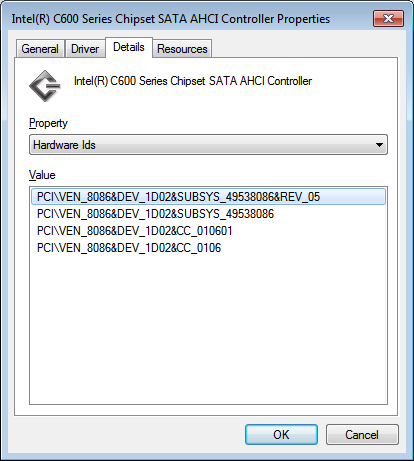
Intel's enterprise chipsets use the Cxxx nomenclature, so this label makes sense. A quick look at Intel's RSTe readme tells us a little more about Intel's C600 controller:
SCU Controllers:
- Intel(R) C600 series chipset SAS RAID (SATA mode)
Controller
- Intel C600 series chipset SAS RAID ControllerSATA RAID Controllers:
- Intel(R) C600 series chipset SATA RAID ControllerSATA AHCI Controllers:
- Intel(R) C600 series chipset SATA AHCI Controller
As was originally rumored, X79 was supposed to support both SATA and SAS. Issues with the implementation of the latter forced Intel to kill SAS support and go with the same 4+2 3Gbps/6Gbps SATA implementation 6-series chipset users get. I would've at least liked to have had more 6Gbps SATA ports. It's quite disappointing to see Intel's flagship chipset lacking feature parity with AMD's year-old 8-series chipsets.
I ran a sanity test on Intel's X79 against some of our H67 data for SATA performance with a Crucial m4 SSD. It looks like 6Gbps SATA performance is identical to the mainstream Sandy Bridge platform:
| 6Gbps SATA Performance - Crucial m4 256GB (FW0009) | ||||||
| 4KB Random Write (8GB LBA, QD32) | 4KB Random Read (100% LBA, QD3) | 128KB Sequential Write | 128KB Sequential Read | |||
| Intel X79 | 231.4 MB/s | 57.6 MB/s | 273.3 MB/s | 381.7 MB/s | ||
| Intel Z68 | 234.0 MB/s | 59.0 MB/s | 269.7 MB/s | 372.1 MB/s | ||
Intel still hasn't delivered an integrated USB 3.0 controller in X79. Motherboard manufacturers will continue to use 3rd party solutions to enable USB 3.0 support.


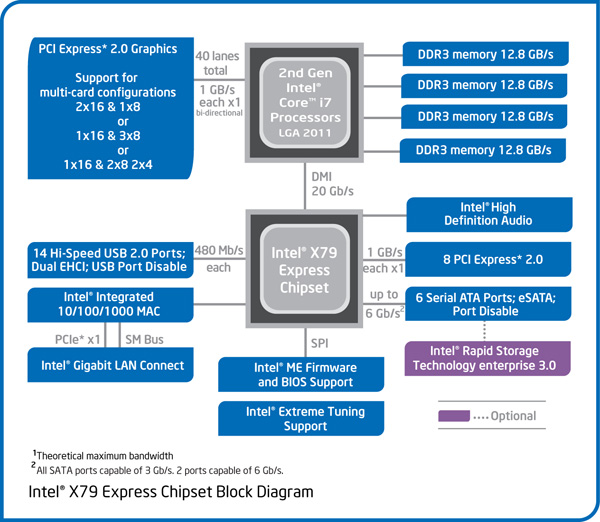
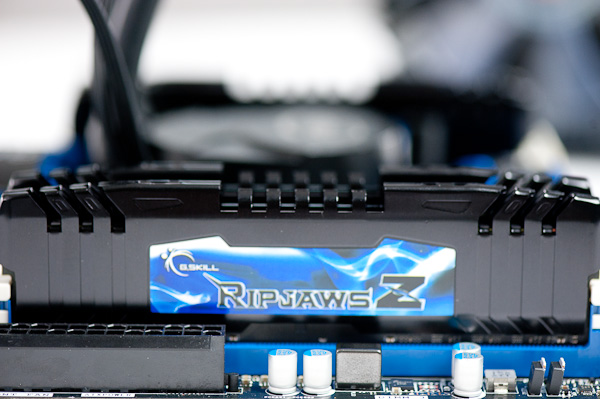
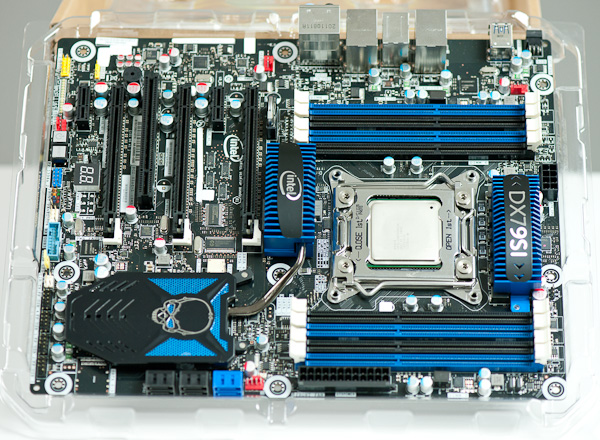
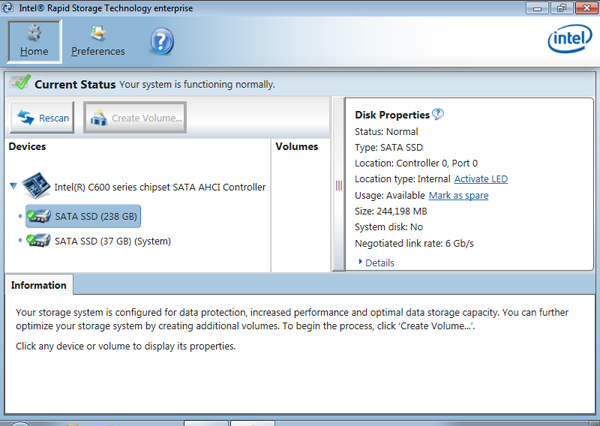








163 Comments
View All Comments
JlHADJOE - Tuesday, November 15, 2011 - link
On Page 2, 'The Pros and Cons':> Intel's current RST (Rapid Story Technology) drivers don't support X79,
Rapid Storage, perhaps?
jmelgaard - Tuesday, November 15, 2011 - link
Computers are only getting faster one way today, and that is more cores, designing for up to a strict number of cores is merely stupidity in today's world.That said, developing games that support multiple cores might be somewhat more difficult than designing highly concurrent applications that processes data or request for data. (I can't say for sure as I have only briefly touched the game development part of the industry, but I work with the other part on a daily basis)
But while you might save development cost right now going down that road, you will spent the savings ones you suddenly have to think 8 cores in.
Carrying technical debt is never a good thing (And designing with a set number of cores in mind can to my programming experience only add that), it will only get more expensive to remove down the road, that has been proven to be true again and again.
And that is even considering that Frostbite 3 might be developed from the ground up, they still have to think up the concept again, while had they gone for high concurrency, then that concept would already be in place for the next version.
TC2 - Tuesday, November 15, 2011 - link
note,BD 4x2bc ~ 2B elements, 315mm2
SB-E 6x2hc ~ 2.27B elements ~ +14%, 435mm2 ~ +38% (includes unused space for 2 more cores), up to 15MB cache, ...
impressive at all!
C300fans - Tuesday, November 15, 2011 - link
Intel Gulftown 6C 32nm 6 1.17B 240mm2Intel Sandy Bridge E (6C) 32nm 6 2.27B 435mm2
I dont see any impressive thing. any performance improves?
Blaster1618 - Tuesday, November 15, 2011 - link
Given QPI @ 3.2 Ghz 205 Gb/s (25.6 GB/s) also handled the PCI load, can't we have something in the middle. I'm still a little confused is DMI 2.0 still just mainly simple parallel interface where QPI is a high speed series interface?C300fans - Tuesday, November 15, 2011 - link
Just imagine DMI 1.0 is a 4pcs pci-e 1x 1.0.DMI 2.0 is a 4pcs pci-e 1x 2.0
jmelgaard - Tuesday, November 15, 2011 - link
Clearly you didn't read a single of my points, or simply lack the understanding.Applications are not developed to target specific cores, you OS handles all that, it is a simple matter of pushing out jobs in threads or processes.
Processing in 10, 100 or 1000 threads/processes is no more difficult than doing it in 4... it just requires you have enough "JOBS" to process (and that term was deliberately chosen)...
This requires a different mindset though, and this might be more difficult to think of games that way right now, mostly because they have been use to running everything in that single game loop, but doing it now could be a rather good ROI down the road.
DarkUltra - Tuesday, November 15, 2011 - link
How about overclocking with turbo boost enabled? I mean, if the 3960X is stable at 4.4GHz, can it be stable at 4.8GHz when games or applications only use four cores? Then it would overclock and perform as good as a 2600K with four heavy threads.yankeeDDL - Tuesday, November 15, 2011 - link
Guys, there are always people with more money than brain that will purchase just about anything.That's not the point. Having the fastest CPU makes it a status symbol and whoever makes it can have the luxury to price it in the $1000 range, for fools to buy.
I don't know about CPUs, but I do know that the top performing GPUs (HD6990 and GTX590) are sold in extremely low volumes, both because of the relatively low ROI, both because the market is so little that inventory are scarce to begin with.
So, you may be right on the CPU side, but in general, you're both wrong.
This said, my point was that if AMD had performed and delivered a good CPU, instead of the FX8150, OR, the FX8150 at a good price point ($170, not $279), then Intel would have had a tougher time in pushing out the 3960X for this price, AND, it would have had to work harder on the chipset. However, because of the huge lead it has over AMD, Intel now can comfortably rebrand a "mid range" chipset and shove it to the customer who has no choice but take it if they want the best CPU.
retoureddy - Wednesday, November 16, 2011 - link
I agree on the fact that only 2 6GB SATA ports are a disappointment. Interesting though is to run two SSD in RAID 0 on the intel controller. With two Kingston SSD I manage real good figures (Crystal Disk Mark) : 4000MB test -> 1040MB/s Read and 621MB/s Write in (SEQ) / 675 and 481 (512K) / 28 and 253 (4K) / 279 and 405 4K QD32. I never managed this kind of throughput on the Z68 or P67 on-board controllers. These numbers are getting close to hardware RAID controllers like ARECA and LSI. I would have been interested to see where the bottleneck lies if X79 would have had more ports. Even though X58 is 3GB Sata you had no problem bottle-necking the Intel RAID controller at around 800MB/s.